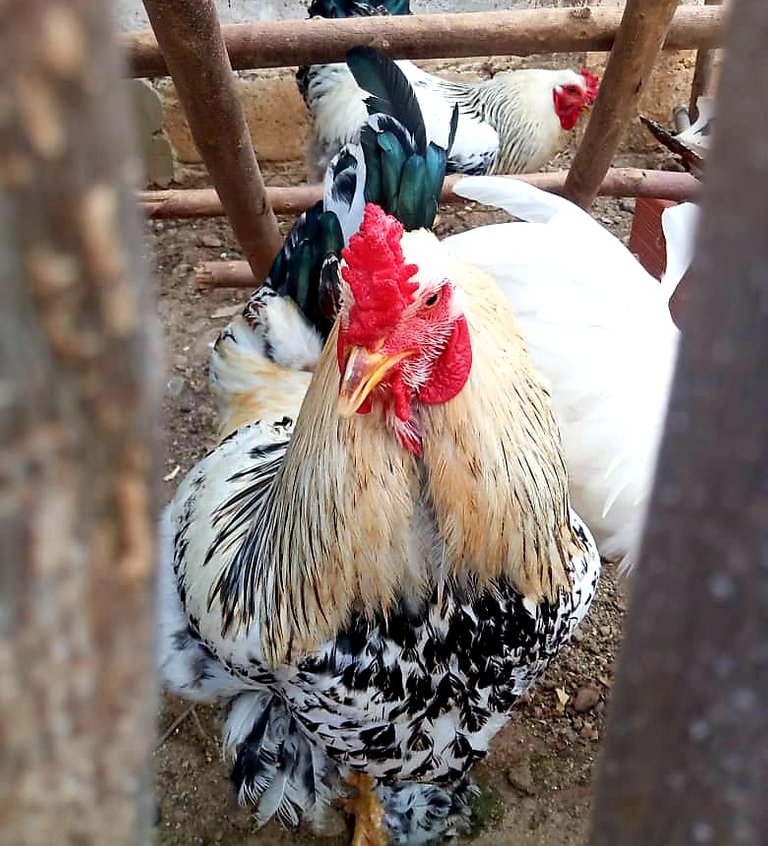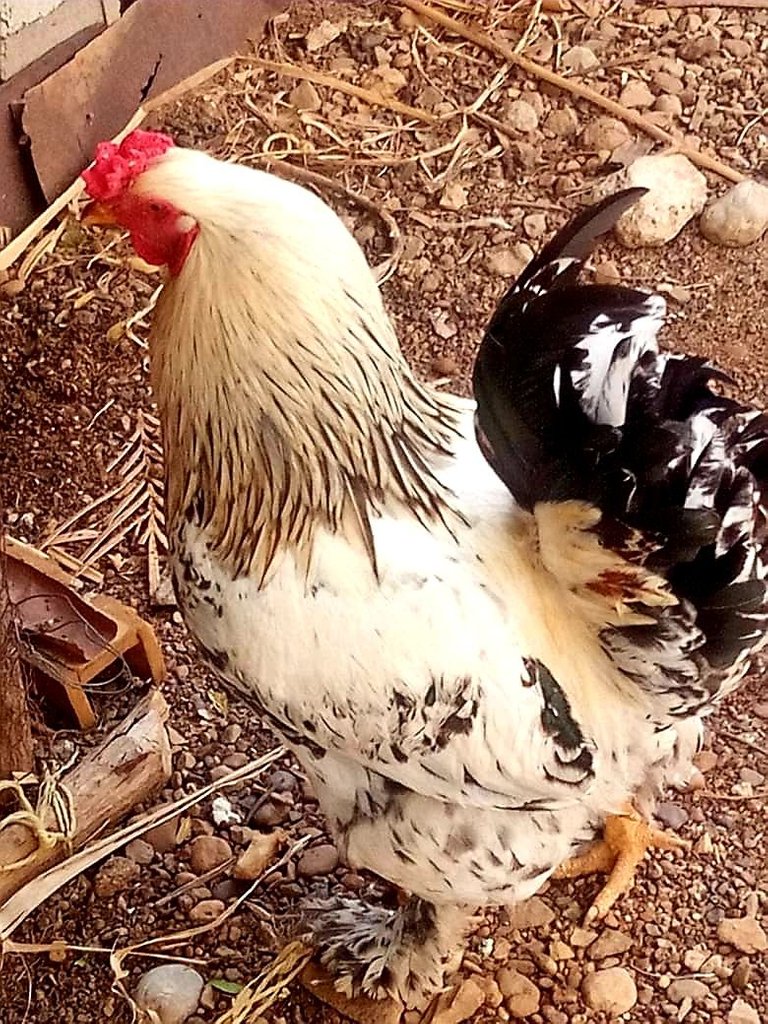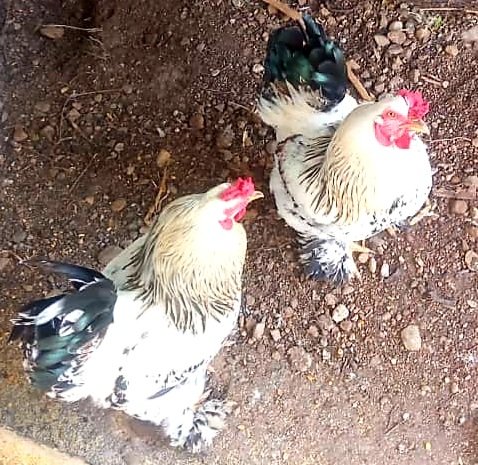
Hello, again your friend Gledys, in this opportunity I will share my personal experience with my husband, about the breeding, care, characteristics and advantages of the birds (Brahma roosters and hens). It is a giant breed of Asian origin whose abundant plumage makes it characteristic when compared to others. They appeared by crossing two Chittagong birds of Malayan origin with the Cochin hen from China. It receives its name Brahma, in honor of the Brahmaputra river in India, channel used for its commercialization.
Main meat breed in the United States between 1850 and 1930. Today they are bred for egg production and even as ornamental birds. In various bibliographies found, all agree that their main characteristic is that of being ornamental, then meat producers and finally, egg production. Small heads, deep black eyes, with pronounced eyebrows, triple or pea-like crest, the head with the tail draws a V-shaped line.
Hola, nuevamente su amiga Gledys en esta oportunidad plasmare mi experiencia personal al lado de mi esposo, sobre la cría, cuidado características y ventajas de las aves (gallos y gallinas Brahma). Se trata de una raza gigante de orígen asiático cuyo plumaje abundante le hace ser característico al compararle con otros. Aparecieron por el cruce de dos ejemplares chittagong de orígen Malayo, con la gallina Cochin de la China. Recibe su nombre Brahma, en honor al río Brahmaputra en la India, canal usado para su comercialización.
Principal raza de carne en los Estados Unidos entre los años 1850 y 1930. Hoy en día se crían para producción de huevos e incluso como aves ornamentales. En diversas bibliografías encontradas todas coinciden en que su principal característica es la de ser ornamentales, luego la de ser productoras de carnes y por último, la producción de huevos. De cabezas pequeñas, ojos negros profundos, con cejas pronunciadas, cresta triple o tipo guisante.La cabeza con la cola dibuja una línea en forma de V.

The plumage on its body is abundant as well as on its legs, reaching up to the middle finger of its extremities, at the level of the knee it has long feathers, called: Swords, the leg is yellow. There is a European and an American breed, the former is more lanky and a little taller, although less corpulent than the American. The male reaches an average weight of 6 to 7 kilos and the female between 4.5 to 5.5 kilos. Although in ancient times they exceeded this weight.
They are passive, friendly, docile birds that can coexist with other breeds without being aggressive. They have a majestic, corpulent appearance, and when walking they raise their legs as if they were marching, a detail that makes them unique. They can be kept in patios, gardens and open spaces where their ornamental aspect can be clearly appreciated. Because of their friendly temperament, they can be used as pets for children. Due to their great weight, they are used in meat and egg production on a smaller scale, laying between 180 to 200 eggs per year. The egg is medium sized and brown in color, they are capable of laying their own eggs, but due to their size and weight it is not recommended, since they can break them when laying on them.
El plumaje en su cuerpo es abundante al igual en sus patas, llegando hasta el dedo medio de sus extremidades.A nivel de rodilla se le aprecia plumas largas, denominadas: Espadas.La pata es de color amarillo. Existe una raza europea y otra americana, la primera es más espigada y poco más alta aunque menos corpulenta que la americana. El macho llega a alcanzar un peso promedio de 6 a 7 kilos y la hembra entre 4,5 a 5,5 kilos. Aunque en la antigüedad superaban este peso.
Son aves de carácter pasivo, amigables, dóciles, que pueden convivir con otras razas sin ser agresivas. Tienen un aspecto majestuoso, corpulento.Al caminar levantan las patas como si estuvieran marchando, detalle que las singulariza. Se pueden tener en patios,jardines, espacios abiertos dónde se aprecia con nitidez su aspecto ornamental. Por su temperamento amigable, sirven de mascotas para niños. Por su gran peso, se usan, en la producción cárnica y de huevos a menor escala,llegando a poner entre 180 a 200 por año. El huevo es de tamaño mediano y color marrón,son capaces de encubar sus propios huevos,pero por su tamaño y peso no es recomendable, ya que los pueden romper a la hora de echarse sobre los mismos.

Incubation time is 21 days, although sometimes some hens lay eggs as early as day 18. It is from the age of 5 months that the hens begin to lay eggs. It is a noble and easy to breed breed breed and due to its remarkable physical characteristics it is a bird that does not fly high, therefore the hen houses do not require high or elevated fences. They are winter hardy animals, due to their abundance of plumage they do very well in cold countries, although they are also bred in tropical countries.
They reach sexual maturity between 6 and 7 months of age. The cock's crowing is loud, strong, with a deep timbre, a detail that distinguishes it from other breeds of roosters. Chicks cannot be easily sexed at birth until they reach 3 to 4 months of age. The way in which the rooster courts the hen, doing a kind of dance and with an extended wing brushing the ground around her and emitting a low, coarse sound, attracts a lot of attention, if the hen appreciates the dance of the rooster, she crouches down, the rooster climbs on his back, attaches his beak to the wings of the head of his partner, occurring the copulation.
El tiempo de incubacion es de 21 días, aunque en ocasiones algunos eclocionan a partir del día 18.Es a partir de los 5 meses en que las gallinas empiezan a poner sus huevos. Es una raza noble y fácil de criar y por sus características físicas notables es un ave que no vuela alto ,por lo tanto los gallineros no ameritan cercas altas o elevadas. Son animales resistentes al invierno, por su abundancia de plumaje se desarrollan muy bien en países fríos, aunque también se crían en países tropicales.
Alcanzan su madurez sexual entre los 6 y 7 meses de edad. El canto del gallo es alto, fuerte de timbre grave, detalle que lo distingue de gallos de otra raza. Los pollitos no se pueden sexar con facilidad al momento del nacimiento,hasta que alcanzan 3 a 4 meses de edad. Llama mucho la atención, la manera en que el gallo, corteja a la gallina haciendo una especie de danza y con una ala extendida rozando con el piso alrededor de ella y emitiendo un sonido bajo y grueso.Si la gallina aprecia el baile del gallo, ella se agacha, el gallo se sube en su lomo ,se sujeta con su pico a las alas de la cabeza de su compañera, ocurriendo la cópula.

In my personal experience, I have seen how the rooster is the one who prepares, searches and makes the nest where the hen will lay the egg, first enters the nest site, lies down, arranges it and gurgles until the hen comes to settle or lay down to start hatching. During the incubation period (21 days), the hen gets up, every 2 or 3 days, for a period of about 20 minutes, eats, drinks, bathes in the soil, stretches and shakes and returns to the nest.
Hens start laying eggs at 5 months of age. My recommendation, in my intention to share is that: Raising these birds is quite profitable, as the investment is recovered, once they start laying eggs. Seeing this as a factor that helps in the economic growth of who is dedicated to this task. They are ornamental birds that can be used as pets. They do not require skilled labor for their manipulation, an adult or a child can take care of them.
En mi experiencia personal, he visto, como el gallo es quien prepara, busca y hace el nido dónde la gallina pondrá el huevo.El gallo entra primero al sitio del nido se echa, lo acomoda y gorgea hasta que la gallina viene a instalarse o echarse para empezar a encubar. Durante el tiempo de encubacion (21 días), la gallina se levanta, cada 2 o 3 días, por un espacio de tiempo de 20 minutos aproximadamente, come, bebe se baña en la tierra, se estira y sacude y vuelve al nido.
Las gallinas empiezan a poner huevos a partir de los 5 meses de edad. Mi recomendación, en mi intención de compartir es que: La cría de estás aves es bastante rentable, ya que la inversión se recupera, una vez que comienzan a poner sus huevos. Viendo esto como un factor que ayuda en el crecimiento económico de quién se dedica a esta tarea. Son aves ornamentales, que podemos usarlas como mascotas. Ellas no ameritan de mano de obra calificada para su manipulación, lo mismo un adulto que un niño, puede atenderles.

With the breeding of these animals, we can use our backyards and gardens as the place where they can be raised, and by having them in our homes, we obtain their products (eggs and meat), healthier, ecological, nutritious, at a lower cost. Finally, when I look at my chicken coop (see how they eat, watch them grow, their behavior), it is a delight, a sense of peace and tranquility that leads to a full mental health, in the midst of a troubled and accelerated society like the one we are living in.
Con la cría de estos ejemplares, podemos utilizar nuestros patios y jardines como el sitio donde pueden criarse.Al tenerlos en nuestros hogares, obtenemos sus productos (huevos y carnes), más sanos, ecológicos, nutritivos, a menos costo. Para finalizar, cuando contemplo mi gallinero (ver cómo comen, verlos crecer, su comportamiento), es un deleite una sensación de paz y tranquilidad que conlleva a una salud mental plena, en medio de una sociedad atribulada y acelerada como la que estamos viviendo.
All photographs are my own/Todas las fotografías son propias

